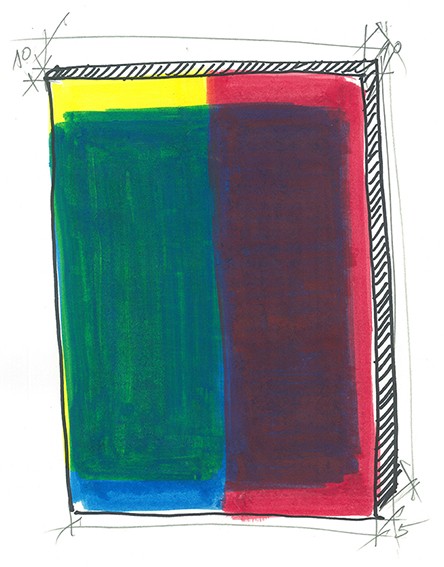RADU COMȘA
Naked and drawing with a compass
February 4 - April 15, 2016
Opening: Thursday, February 4, 6-8:30 p.m.

Colour-Birth by Golden Section
Colour is not a characteristic of things, but an element of the world which has self-standing meaning and laws. (Béla Hamvas)
The fairy tales of our childhood have sent all of us through enchanted castles, gilded halls, or Ali Baba’s hidden treasure cave, bloody history has shown us the mysteriously lost Amber Room or Atahualpa’s room in Cuzco, laden with gold. Still, nobody has ever heard of the Room of Golden Section, let alone crossing its threshold. If you don’t believe this exists, go and see for yourself! And you don’t even have to cross the Seven Seas, just wander through Sabot gallery in the Paintbrush Factory in Cluj, through the most recent show of Radu Comşa, and you can get the instant proof that there is indeed such a golden section room on Earth.
Here, at an effervescent spot of the creative latitudes, Radu Comşa experiments with the creation of a contemporary exhibition space organized by the “divina proportione”. This is a rationally structured space under the spell of irrational numbers, where every painting is a “golden rectangle”, with every colour field “breathed” on it in accordance with the “sectio aurea”. Comşa followed three basic principles when setting out to create this golden harmony: chromatic, conceptual, and compositional. Namely, the principles of colour theory, the mixing, the alchemy of colours; the abstract, sublimating, conceptual painterliness; and the image plane, the spatial structure that follows the rules of the golden section.
As a chromatographer of the spirit, Comşa tries to transform the quantitative rate indicators of arithmetic, the science of numbers, into qualitative colour-tastes. His work draws inspiration from the spirit of the great masters, but without their millenary techniques. He uses methods closer to modern technological solutions, such as printing, the chromo-phototype, or serigraphy. Despite all appearances, he paints his work by hand, with extreme attention, similarly to the technique of batik painting. He disregards traditional painterliness and uses not an oily, mixed paste, but touches his canvas with a sublimated, more conceptual colour vision. He uses additive colour mixing, so that he paints the diluted but unmixed, pure primary colours in a set proportion over one another. This way, combined with the shine of the white canvas, he creates a translucent optical colour mixture. The chromogenous, colour-siring subject is the filtered light itself. It is the color-genesplicer, while the painter is playing the role of the prism. Comșa becomes thus a colour-diffractor operating with the “golden triangle”. The colour-derivating process comes into being by colour-shifting, chromatic aberration. Then he sprinkles “stardust” over the silky canvas, bringing to life a velvety, glimmering chromatron projection of mysterious abyss, a magically iridescent screen of colours. This chromatized kinescopic projection radiating from the depth is, firstly, a diaphanously painted colour field. But divided with the “sacred section”, it turns into post-Euclidian, space-forming, limitlessly extended chromatophores, colour-bodies. Dived into these, the colour-breath from beyond becomes inhalable. Comşa, as we see, creates a metaphysical chromosphere around us, just like Mark Rothko has done.
The diagonally twisted canvas stretchers slant the painterly planes, not only lending a new pulse to the colour planes, but adding planes of light to the elaboration of the visual experience. Using this technique, Comșa is also playing with the subtle differences of light reflection. He creates thus a somewhat immaterial, sublimated, “lightyform” or “lighteous” painterliness. Although divided by lines of composition, by the rule of the “divine proportion” and the Phi (Φ), the colour fields remain plasmatic and vaporize together. These proportional lines and curves do not completely frame and cage them like in Mondrian’s paintings. The colour-halos of chromatic plasmas border on each other and pulsate together.
Comşa is not merely the midwife of colour birth, but also the engineer of the colour space. He divides the entire exhibition area using the “divine proportion”, the “golden section”, Fibonacci’s magic sequence, in such a way that the size, composition, colour proportion of the paintings stand in a balanced harmony with each other and the space of the gallery. He articulates, requalifies and incorporates the physical space into a painterly space. We as spectators also step into this space. He employs the three dimensions of the exhibition room as a painterly surface, using the “golden ratio” to create a uniform balance in the entire spectrum of colours, from proto-greys to primary colours, in the division of golden section lines, in the colours of space and the space of colours, and even in the chromo-somas of all the entrapped photons. This is a creation of world order by irrational numbers, in our microscopic size, at room temperature. A colourful micro-cosmology. Chromatic dimension gates opening from our Euclidean prison cell. A complex painterly balance and search for harmony, in such a way that opposing signs (lines, patches, shades) correspond to each other, and raise above analogies, mutually pervading each other and merging into a conjoined unity. Kandinsky writes about this same consonance of the whole world in his theosophical theory of art. Comșa also studied Leon Battista Alberti’s treatises and the secret geometry of the great masters. Drawing on this wisdom of image design, he tries to translate this secret geometry of nature, of the universe, and its aggregation by numbers into the language of a diffuse, expansive, abstract painterliness. He paints the icons of mathesis by the projection of some essential super-qualities. He tries to meld the concealed order of the world with the proportion of the “suprematist” Phi (Φ) sequence.
What is this Phi, this “divine proportion”, in number theory? Well, paper is too tiny to explain it, not to mention myself. According to the Pythagoreans, the number, the arithmos is the basic principle, the primary reason of the world. It was endowed with divine attributes. They considered numbers to be the manifestations and revelations of archetypal image models. The millenary sages thought that the universe was created according to number, measure, and weight. It is the basic organisational principle, axiom of the palpable, manifest world, but it has a progression which transgresses the quantitative value. This is the “eidetic” number which governs the noetic world, the realm of ideas. First of all, this Number possesses quality and its physical projection appears in geometry as well. Architects and painters have used for thousands of years the sacred geometry and the Phi number sequence, the Golden Section, to create perennial works of art of unfading beauty.
This has been the inspiration of Radu Comşa as well, but he does not paint the cognitive experience of numbers. His experience is rather intuitive, a chromo-hint of numerical proportions and a fundamental desire for pristine harmony. This golden-geometry cabin turns into a chromo-scene of chromo-confession, where our discoloured personality undergoes a trans-colouration, where we can heal our faded lives and the hue-blindness of our soul, and where we can inhale also some tinctures of the universe.
Géza Dabóczi
translated from Hungarian by Emese Czintos

